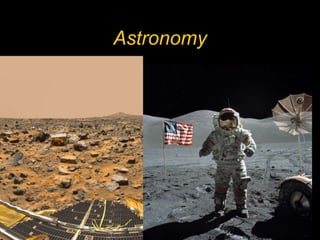
astronomy introduction
- 1. Astronomy
- 2. What is Astronomy? Astronomy is the study of anything we see in the sky, and beyond Overlaps with physics, chemistry, geology, and other sciences
- 3. The Scientific Method in Astronomy Astronomy is one of the most difficult sciences to do, because we can’t do very many things in a lab We have to combine our observations with our understanding of other sciences to make good predictions Sometimes, our “lab” is a computer
- 4. Astrology Astrology - the belief that the stars and planets affect your life Despite the –ology, it’s not a science! Gravity of other planets is not as strong as the gravity of your obstetrician! Does not use the scientific method It’s complete poppycock
- 5. Observing the Universe Astronomy began with people observing their surroundings What did the sky look like when herds moved? When a season changed? When was it good to plant? Planets, sun, moon, and stars all seemed to move independently
- 6. What have you Observed? An incomplete list: Moon Planets (Venus, Mercury, Mars, Jupiter, Saturn) Stars Meteors (shooting stars) Aurora Comets
- 7. What’s Out There, Anyway? Atmospheric phenomena Solar System Sun and planets; comets, asteroids, etc. Milky Way Our galaxy Extra-galactic Other galaxies Some objects like our galaxy Some completely different phenomena Things between galaxies
- 8. Atmospheric phenomena Auroras Meteor Showers
- 9. Solar System Objects and Phenomena The Sun Eclipses Planets & Moons Asteroids Comets
- 10. Galactic Objects and Phenomena Stars & star clusters Nebulas Supernova Remnants Dead Stars White Dwarfs Neutron Stars Black Holes Dark Matter
- 11. Extra-Galactic Objects and Phenomena Other Galaxies Galaxy Clusters Super Clusters Dark Matter Dark Energy
- 13. Neighborhood Tour - Our Solar System
- 14. The Solar System • Condensed from Solar nebula about five billion years ago • Contains Sun, planets, asteroids, comets, and dust
- 15. Terrestrial verses Jovian Planets Terrestrial Planets Include: Mercury, Venus, Earth and Mars Jovian Planets Include: Jupiter, Saturn, Uranus & Neptune Also Interesting: Jovian moons Not sure what to do with them: Pluto/Charon Xena
- 16. Sol (our sun) SOHO/Extreme Ultraviolet Imaging Telescope (EIT) consortium
- 17. The Solar System
- 18. Terrestrial Planets Small and rocky, composed of Oxygen, Silicon, Aluminum, Calcium, Iron, and Magnesium 1. Mercury 2. Venus 3. Earth 4. Mars
- 19. Mercury Mercury has a lunar-like geology. Caloris Basin
- 20. Mercury Mercury is almost tidally locked, like the Moon.
- 21. Venus Venus’ surface has only been revealed in the past 10 years.
- 22. Venus The surface of Venus is like the surface of hell.
- 23. Venus Venus has a young, basaltic surface.
- 24. You Probably Know This One
- 27. Mars Mars has the most Earth-like geology.
- 28. Mars Mars has a thin atmosphere of CO2.
- 31. Mars Mars’ geologic history was once warmer and wetter than now.
- 32. The Real Face of Mars
- 34. Sojourner
- 35. Olympus Mons
- 36. Mars’ Polar Caps
- 40. Jovian Planets Large, gaseous, composed mainly of hydrogen and helium 1. Jupiter 2. Saturn 3. Uranus 4. Neptune
- 41. Jupiter Jupiter’s geologic features are all atmospheric.
- 44. Moons of Jupiter Io is the most active body in the Solar System.
- 45. Moons of Jupiter “All these worlds are yours except Europa…”
- 46. Moons of Jupiter Ganymede and Callisto are two of the larger bodies in the Solar System.
- 47. Saturn Saturn is the furthest out of the historical planets.
- 48. Saturn’s moons
- 49. First ever color picture of Titan’s surface Water and hydrocarbon ice January 14, 2005 ESA/NASA/Univ. of Arizona
- 50. Uranus & moons Uranus orbits the Sun on its side.
- 51. Neptune & moons
- 53. Pluto & Charon
- 55. Units for Measuring Astronomical Distances Astronomical Units (AU) Defined as the distance from the Sun to the Earth About 1.496x1011 m (about 150 million km) Light-years Defined as the distance light travels in one year About 9.46x1015 m Parsecs Derived from the way stars appear to shift slightly in the sky as the Earth orbits the Sun Equal to about 3.26 light-years
- 56. How Big Is It? Our Earth 12,756 km across Earth to the Moon 384,400 km Earth to the Sun 150 million km = 1 AU = 500 light-seconds
- 57. How Big Is It?, cont. Sun to Jupiter 5.2 AU Sun to Pluto Between 30 and 49 AU Oort Cloud Theoretical, unobserved edge of the Solar System Out to about 50,000 AU (= 0.79 light-year)
- 58. How Big Is It?, cont. Nearest star 4.2 light-years away Our Galaxy 100,000 light-years across To the nearest large galaxy 2.5 million light-years away
- 59. How Big Is It?, cont. Virgo Cluster of Galaxies Nearest cluster of galaxies to us About 50 million light-years (debated) Quasar 3C 273 One of the nearest and brightest quasars About 2 billion light-years Edge of the observable Universe About 13.7 billion light-years away
- 60. Light travel times… Across earth: 0.04 seconds From moon: 1.3 seconds From sun: 8 minutes From Neptune: 4 hours
- 61. Light travel times… From nearest star: 4 years From galactic center: 25,000 years From Andromeda galaxy: 2 million years From hot early universe: 14 billion years